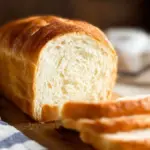When it comes to the comforting scent of freshly baked bread wafting through your home, nothing quite matches the experience of making white bread from scratch. This simple yet scrumptious recipe transforms basic ingredients into something wholesome, fluffy, and utterly delicious. Whether you plan on crafting sandwiches, toast, or indulging in a slice with a bit of butter, homemade white bread has an unmatched charm and taste that store-bought options simply can’t replicate.
Why We Love This White Bread Recipe
This white bread recipe is beloved by many for its simplicity and reliability. It requires just a handful of common ingredients, making it easy to whip up whenever you have a craving for fresh bread. The texture is perfectly soft and tender, inviting you to take just one more slice. The versatility of white bread allows you to enjoy it with various spreads, toppings, or even as a base for dish creations. Plus, the process of kneading dough and watching it rise is not only satisfying but also therapeutic.
When you make your bread, you have complete control over the ingredients, allowing you to avoid preservatives and artificial additives frequently found in commercial breads. The result is a loaf that is not only fresher but also packed with flavor that elevates any meal.
Ingredients About White Bread
To craft a delightful white bread loaf, you will need the following essential ingredients:
- 1 2/3 cups lukewarm water, divided
- 2 1/4 teaspoons instant yeast or active dry yeast
- 1 teaspoon sugar
- 1 tablespoon honey (or more sugar, if preferred)
- 1 teaspoon salt
- 1 1/2 tablespoons unsalted butter, cubed and at room temperature
- 4 1/2 cups all-purpose flour, divided
- 1 1/2 tablespoons butter, melted for brushing on top
Each of these basic ingredients plays a vital role in the bread-making process. The yeast activates the dough, the sugar helps in fermentation, and the butter ensures a tender crumb.
How to Make White Bread Directions
Embarking on the journey to create your white bread is straightforward and enjoyable. Begin your adventure by gathering your ingredients. Here’s how to bring your loaf to life:
- Activate the Yeast: In the bowl of your stand mixer fitted with a dough hook, combine the instant yeast, sugar, and half of your lukewarm water. Allow this mixture to rest for approximately 5 to 10 minutes until it becomes foamy. This step is crucial, as it ensures that your yeast is active and ready to help the bread rise.
- Combine Ingredients: After the yeast is activated, add the remaining lukewarm water, honey, salt, cubed butter, and 4 cups of all-purpose flour to the bowl. Start kneading at low speed, allowing the ingredients to come together. Continue kneading for about 6 to 9 minutes or until the dough is soft and no longer sticky. If it feels too wet, don’t hesitate to add a little more flour, a tablespoon at a time.
- First Rise: Transfer the kneaded dough into a lightly greased bowl. Cover it with plastic wrap and let it rise in a warm environment for around 45 minutes. You want it to double in size during this time, which signals to you that the yeast is doing its job effectively.
- Shape the Dough: Once your dough has risen, turn it out onto a lightly floured work surface. Divide the dough into two equal portions and shape each into an 8×12 inch rectangle.
- Roll and Seal: Start rolling each rectangle tightly from one long side. Be sure to seal the seams neatly and tuck the ends under to create a nice loaf shape.
- Prepare for Second Rise: Place each rolled loaf into a greased 8×4 inch loaf pan with the seam side down. Cover them again and allow them to rise for another 45 minutes. This second rise is vital, as it helps to develop the structure and texture of your bread.
- Preheat the Oven: While your loaves are enjoying their warm resting place, preheat your oven to 390°F (200°C).
- Bake the Bread: After the second rise, place the pans in your preheated oven and bake for about 25 to 30 minutes. You are looking for a beautiful golden-brown crust and an internal temperature of around 208°F to 210°F, which indicates that your bread is perfectly baked.
- Cool and Enjoy: Once baked, invert the loaves onto a cooling rack and brush the tops and sides with melted butter. Allow them to cool completely before slicing for the best texture and ease of cutting.
Congratulations! You’ve just created two lovely loaves of white bread that are bound to impress and satisfy any bread lover.
How to Serve White Bread
The beauty of homemade white bread lies in its adaptability. It is suitable for a variety of occasions and can be served in numerous ways.
- Classic Sandwiches: One of the most popular ways to enjoy white bread is to create sandwiches. Whether you prefer a classic ham and cheese, a turkey club, or a hearty vegetarian option, the soft texture of the bread perfectly complements your favorite fillings.
- Toasted Delight: Slice up a loaf and toast it until golden to create an irresistibly crunchy exterior. Spread a bit of butter, homemade jam, or even avocado for a lovely breakfast or snack.
- Soup Companion: Serve warm slices with your favorite soups or stews to soak up the flavors. The bread acts as an excellent accompaniment, enhancing your meal experience.
- French Toast: If you’re looking for a delightful breakfast option, use your homemade white bread to make French toast. The thick slices soak up the egg mixture beautifully, resulting in a deliciously custardy inside with a lightly crisped exterior.
- Bread Pudding: Transform leftover bread into a comforting dessert by making bread pudding. This dish is a perfect way to utilize any stale slices.
No matter how you choose to serve your white bread, it remains a versatile staple that can elevate any meal.
Expert Tips: White Bread
Creating the perfect loaf of white bread can sometimes feel daunting. However, these expert tips will guide you to success:
- Use Quality Ingredients: Always prefer high-quality flour and fresh yeast. The quality of your ingredients directly impacts the final flavor and texture of your bread.
- Knead Properly: Proper kneading develops gluten, which gives the bread its structure. Don’t rush this process; if kneading by hand, it may take longer, but the result is worth it.
- Watch the Temperature: Make sure your water is lukewarm—too hot can kill the yeast, while too cold may not activate it properly. Aim for around 110°F for optimum yeast activity.
- Be Patient: Allowing your dough to rise adequately is essential. If you’re in a colder environment, consider placing the covered bowl in a warm oven (turned off) or near a warm stove.
- Test for Doneness: Use a thermometer to check instead of relying on appearance alone. This ensures that your bread has fully cooked through.
With these tips, your white bread journey will become a satisfying culinary adventure.
How to Store White Bread
You’ve successfully baked your white bread, and now it’s essential to store it properly to maintain freshness. Here are some effective storage tips:
- Room Temperature: If you plan to consume the bread within a few days, store it at room temperature. Keep it in a paper bag or wrapped in a clean kitchen towel to prevent it from getting too moist and returning to its fluffy texture.
- Freezing: For longer storage, slice the bread and place it in an airtight container or a resealable plastic bag before freezing. This way, you can enjoy fresh-tasting slices without the hassle of thawing the entire loaf.
- Avoid Refrigeration: While it may seem logical to keep bread in the fridge, this can lead to faster staleness. Refrigeration changes the bread’s structure, making it dry out more quickly.
- Reviving Stale Bread: If your bread does start to go stale, don’t despair! You can dampen it slightly and place it in a preheated oven at 350°F for about 10 minutes. This gives the bread a second life.
By following these storing methods, you can enjoy your homemade white bread for days to come.
Variation of White Bread
While the classic white bread recipe is a fantastic foundation, you can easily experiment with flavors and textures by trying out variations. Here are a few ideas to inspire you:
- Whole Wheat White Bread: Substitute half of your all-purpose flour with whole wheat flour for added nutrition and a slightly nuttier flavor.
- Herbed White Bread: Add dried herbs such as rosemary, thyme, or oregano to your dough for a delightful savory twist. This bread pairs wonderfully with soups and salads.
- Garlic White Bread: Incorporate roasted garlic cloves into your dough to create a fragrant loaf. This bread is excellent for garlic bread lovers to serve alongside pasta dishes.
- Cheese-Stuffed White Bread: For a decadent variation, fill the rolled dough with shredded cheese before shaping. The melted cheese adds a savory surprise with each slice.
- Fruit and Nut White Bread: Add chopped nuts or dried fruits like cranberries or raisins to the dough. This variation works perfectly as a delightful breakfast or snack option.
These variations allow you to create fun and dynamic bread experiences while still enjoying the foundation of your beloved white bread recipe.
Frequently Asked Questions
What is the best way to make sure my white bread rises properly?
To ensure your white bread rises well, activate your yeast correctly and maintain warmth during the rising process. A warm, draft-free environment is vital for optimal fermentation.
How do I know when my white bread is done baking?
You can check the internal temperature using a kitchen thermometer; it should read 208°F to 210°F when fully baked. Additionally, the bread will have a nice golden-brown color, and tapping the bottom will produce a hollow sound.
Can I use all-purpose flour for white bread?
Absolutely! All-purpose flour is perfect for making white bread. It provides the necessary protein content to create a light and airy texture.
Can I make white bread without a stand mixer?
Of course! You can knead the dough by hand on a floured surface. Just be patient and knead for about 10-12 minutes until the dough is smooth and elastic.
How long will my homemade white bread last?
When stored properly at room temperature, homemade white bread will stay fresh for about 2 to 3 days. If frozen, it can last for several months.

White Bread
Equipment
- Stand mixer with dough hook
- Mixing Bowl
- Loaf pans
- Oven
Ingredients
- 1 2/3 cups Lukewarm Water Divided.
- 2 1/4 tsp Instant Yeast Or active dry yeast.
- 1 tsp Sugar
- 1 Tbsp Honey Or more sugar if preferred.
- 1 tsp Salt
- 1 1/2 Tbsp Unsalted Butter Cubed and at room temperature.
- 4 1/2 cups All-Purpose Flour Divided.
- 1 1/2 Tbsp Butter Melted for brushing on top.
Instructions
- In the bowl of your stand mixer, combine the yeast, sugar, and half of the lukewarm water. Let it rest for 5 to 10 minutes until foamy.
- Add the remaining water, honey, salt, cubed butter, and 4 cups of flour. Knead at low speed for 6 to 9 minutes until soft and no longer sticky.
- Transfer the dough to a greased bowl, cover with plastic wrap, and let it rise in a warm place for about 45 minutes, or until doubled in size.
- Turn the dough out onto a floured surface, divide it in half, and shape each half into an 8×12 inch rectangle.
- Roll each rectangle tightly from one long side, seal the seams, and tuck the ends under.
- Place each loaf seam-side down in a greased 8×4 inch loaf pan. Cover and let rise for another 45 minutes.
- Preheat your oven to 390°F (200°C).
- Bake the loaves for 25 to 30 minutes until golden brown and the internal temperature reaches 208°F to 210°F.
- Cool the loaves on a wire rack and brush the tops with melted butter. Allow to cool completely before slicing.
Send me this recipe!
Just enter your email below and get it sent straight to your inbox!



